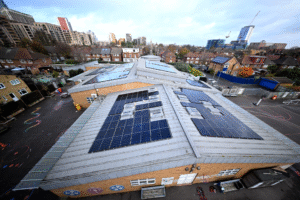This summer, there are plans to conduct seismic surveys off the coast of Cumbria, to investigate the feasibility of depositing heat generating, high level nuclear waste in a Nuclear Geological Disposal Facility (GDF), at a depth of up to 1000 metres below the seabed. Charlie Jaay reveals the devastating impacts this may have for marine life, and investigates whether deep sea disposal is an appropriate solution for our growing nuclear waste problem.
These tests have been commissioned by the UK government’s Nuclear Waste Services, which is responsible for finding a location for a GDF into which waste from Britain’s nuclear reactors can be deposited.
Chris Eldred, Senior Project Manager for Geosphere Characterisation at Nuclear Waste Services, is involved with this search. ‘These surveys will support our assessment of the deep geology and its potential suitability to dispose of radioactive waste for the long term. We are committed to environmental protection and will work to minimise the impact of these surveys on marine life by following relevant UK guidance. We are obtaining all necessary permissions and the surveys will be closely monitored to identify and avoid any potential impacts in line with industry best practice,’ he explains.
‘The information we obtain from these surveys will enable us to better understand whether a location could host a GDF and in turn will help inform discussions with communities.’
Shearwater GeoServices – the same company which at the end of last year saw the high court put an end to its work on South Africa’s ecologically sensitive Wild Coast, after almost half a million people signed a petition – has been contracted to carry out this survey.
As part of a continuous 24-hour operation which will last around three or four weeks between July and August, loud, repetitive blasts of sound will be produced from an airgun every 10 seconds all day, every day throughout the survey period, meaning there will be over 60,000 of these blasts each week.
The airgun will be about five metres below the water surface and the sound will be directed towards the seabed. It will penetrate deep under the ocean floor, to relay back information about the thickness, layering, and depths of the different rock types.
Noise from these seismic blasts extend over thousands of kilometres, particularly in deeper water, impacting a wide range of marine life – from zooplankton, which are a crucial marine food source, to commercially important fish species and marine mammals such as porpoises, whales and dolphins.
Effects from blasting not only cause stress, but can also damage hearing and health, and impair ability to navigate, find food, communicate, breed and migrate. Organ and tissue injury can also result.
Dr Chris Parsons, Marine Mammal Scientist, tells Environment Journal: ‘There is a lot of scientific evidence about the problems underwater noise can lead to – seismic surveys roughly 3000 km away were loud enough to drown out the mating calls of whales on the middle of the Atlantic. Conducting seismic surveys in an area known to be inhabited by many highly sensitive species is really concerning.’
The NWS investigation will, initially, focus on the deep geology within the inshore area off Copeland, five to 20 kilometres beyond the coast, in an area approximately 250 kilometres square. It is proposed that the GDF may consist of possibly two vaults extending over an area of 25 kilometres square, deep beneath the seabed.
West of Copeland is one of a number of designated Marine Conservation Zones in the Irish Sea. A number of European Protected Species, such as Common and Bottlenose Dolphins, Harbour Porpoise, Minke Whales and Sea Turtles are found here and, according to the North West Wildlife Trust, these Marine Conservation Zones are also ‘crucial to the recovery of an array of underwater habitats and threatened species that have suffered from decades of over-exploitation’.
There is a growing body of research confirming the damage caused by seismic testing. However, the Marine Management Organisation (MMO), which is responsible for licensing and regulating marine activities in England and Wales to ensure they are carried out in a sustainable way, deems that ‘underwater noise from the seismic survey operations is unlikely to pose a significant risk to marine mammals and fishes in terms of auditory injury within the survey area and time frame proposed’. But, this has been shown not to be the case on numerous occasions.
The Zoological Society of London’s Cetacean Strandings Investigation Programme (CSIP) is responsible for recovering, and then investigating how and why whales and dolphins strand around the English and Welsh coast.
Speaking to Environment Journal, CSIP project manager, Rob Deaville argues: ‘Through the course of our investigations over the last 30 years, we know that noise exposure can be a problem for a wide variety of cetaceans – dolphins, porpoise and whales. Noise related impacts have also been causally linked to many cetacean stranding and mass stranding events globally.
‘Various potentially vulnerable cetacean and other marine species are normally resident across this region, and we’re concerned that the proposed use of seismic surveys over the summer could lead to a number of impacts, ranging from temporary displacement to more direct physical effects, including mortality.’
One of these mass strandings occurred in 2012, when seismic testing was utilised off the coast of Peru, and over 800 dolphins died. Dr Carlos Yaipén-Llanos, Marine Veterinarian and Director of ORCA, the Organization for Research and Conservation of Aquatic Animals, carried out necropsies and found the dolphins were bleeding from their middle ears, had gas in their internal organs and Severe Acute Pulmonary Emphysema. He said there was unequivocal evidence the dolphins had died of Decompression Sickness, caused by acoustic trauma, although both Peru’s Government and the company involved with the seismic survey denied this was the cause of death.
‘All dolphins were found in good physical health and many had stomachs filled with fish. We found no evidence of acute or chronic disease. There were no parasitic, bacterial or viral infections and no long term nutritional, metabolic or degenerative diseases. We also ruled out temperature changes in the ocean causing these casualties because Common Dolphins are a highly migratory species and are not affected by this.’
‘This Unusual Mortality Event is a worldwide call for attention towards a constant acoustic issue filling our oceans,’ he added.
According to Yaipén-Llanos, there were also no signs of toxicity in the casualties and no other cetacean species were affected, but had the seismic testing occurred in a different season then, he says, others would have suffered.
Marine Radioactivity Researcher and Consultant, Tim Deere-Jones, has been commissioned by the campaign group Radiation Free Lakeland (RFL) to carry out what it feels is necessary research before the seismic survey is due to begin.
‘I am carrying out research equivalent to some aspects of an Environmental Impact Assessment (EIA), because it had become apparent that the Marine Management Organisation was minded to reject Natural England’s advice that an EIA was required and accept the UK Government’s Nuclear Waste Service submission that an EIA was not needed in the case of the proposed marine survey,’ Deere-Jones says.
‘However, in the context that there is a widely publicised consensus that air gun acoustic surveys have negative impacts on the health of marine species, RFL believes that there is a need for an EIA of some form in order to inform the public of any scientific empirical evidence there may be on the possible negative environmental impact of the proposed survey and review the academic literature on potential alternative survey techniques,’ he adds.
When asked for comment on the above points (i.e. noise pollution and licenses), an MMO spokesperson said: ‘We are currently considering an application for a Wildlife Licence (European Protected Species) relating to this seismic survey. The outcome is yet to be determined.’
According to Stuart Haszeldine OBE FRSE C.Geol, Professor of Carbon Capture and Storage, University of Edinburgh, the geology of this survey area could also prove to be problematic. Offshore of Sellafield and Copeland is known to be layered and faulted sedimentary rocks, which are sandstones, limestones and mudrocks. In the coastal and near shore zone, these rocks have complex faulting, and lie on the outflow end of a regional groundwater system – making a Repository very difficult to position for secure containment. Those faults extend north-west to the proposed offshore coal mine at Whitehaven, which would usually be excluded from development.
‘The UK radwaste industry has a prolonged history of trying to construct a GDF as close as possible to Sellafield. Closer to shore will look cheaper to engineers – and that is probably why Radiation Waste Management may focus there,’ Haszeldine says, ‘But when the fully engineered security is built in, an extra 15km of access tunnel may well be out priced by having to stabilise near shore faults.’
‘The proximity of proposed coal mining along the extended trend of the coastal faults is a serious geological issue – stress change in those rocks subsea and possibly even subsidence could jump 20km along a fault to affect the proposed GDF site close to the coastline. Awarding planning permission to the coal extraction could sterilise the GDF area for very long duration development.’
‘Places with a lot of faulting are difficult to engineer for 1,000,000 years into the future, particularly as changes of sea level and, in the further future – glaciation, will likely reactivate those faults,’ he adds.
Radiation Free Lakeland was founded by Marianne Birkby, in 2008, when plans for preliminary work on an underground nuclear storage facility in Cumbria were announced. However, in 2013, they were rejected and scrapped. Birkby is now campaigning against plans for a GDF in her home county for the second time, and has set up Lakes Against Nuclear Dump. She has planned a rally for June 9, to increase awareness of the effects of seismic testing on the marine life of the Irish Sea.
Credit: Radiation Free Lakeland‘The authorities have proven they cannot contain the waste above ground at Sellafield, so putting it deep under the sea is so scary,’ she explains. ‘It is completely unjust, unscientific and immoral.’
‘The government wants new nuclear build, so needs somewhere to brush the waste out of sight, out of mind, and Nuclear Waste Services are already steaming ahead with these plans, without any public consultation whatsoever.’
The UK government, similar to many others, favours deep geological disposal as the preferred solution for final disposal of the most radioactive waste. However, there are still many concerns around the idea of storing high level nuclear waste in a GDF, whether deep below ground or deep beneath the seabed. This costly facility, whose upper range of current estimates stands at £53 billion has, as yet, never been tried and tested, so provides no absolute guarantees over storage.
The Nuclear Free Local Authorities (NFLA) are the local government voice on nuclear issues, and 50 councils throughout the UK currently support NFLA policy work. They are extremely concerned about establishing any nuclear waste dump below the seabed, because of the extreme difficulties which would be involved with retrieving any leaking waste.
The waste would be left in situ, in the GDF, for millennia and, say the NFLA, no matter how effective the barriers inside, some of the radioactivity will eventually reach the surface, with leakage rate poorly predicted.
According to Cllr David Blackburn, Chair of the NFLA Steering Committee, it is unlikely that any leaked radiation would be easily detected.
‘The Irish Sea and the coasts of West Cumbria are already abnormally irradiated from the operations of the Sellafield complex; it would be unlikely that the leakage of radiation from a facility beneath the seabed would be detected for some time given the pre-existing background radiation.
‘Consequently, rather than solving a problem for future generations, it could be leaving them a legacy of a nuclear waste dump gradually releasing radioactivity into the environment and cutting off their options for deciding how to deal with this waste. There could also be a negative impact on the UK’s relations with our immediate neighbours, relationships already damaged because of Brexit, because pollution does not respect national borders.’
The NFLA instead favours the near surface, near site storage of waste at the nuclear facility which produced it. This means waste can be monitored and managed, and action can be taken if it begins to leak. Such an approach also eliminates the need to transport waste by train over long distances.
‘Given time, further scientific research may yield advancements that could mean radioactive waste can be treated such as to make it less toxic in a shorter time period, chucking it in a hole in the ground or under the seabed precludes this possibility,’ Blackburn explains.
Back in 1976, the Royal Commission on Environmental Pollution warned: ‘It would be irresponsible and morally wrong to commit future generations to the consequences of fission power unless it has been demonstrated beyond reasonable doubt that at least one method exists for the safe isolation of these wastes for the indefinite future.’
As yet, no suitable, permanent and safe storage method has been found, for the high-level nuclear waste, which remains hazardous for many thousands of years. However, after more than 70 years of using nuclear power for electricity generation, 250,000 tonnes, produced in a facility’s day to day operations, is currently in temporary storage on site at nuclear power plants around the world. Sellafield, in the UK, is home to the largest amount of untreated nuclear waste on earth, including 100 tonnes of plutonium, and suffers from extensive contamination. The final disposal of this ever-growing amount of nuclear waste poses major challenges to governments throughout the world and, as yet, no country has a final nuclear waste disposal site in operation.
The UK government has been looking for a suitable GDF site – either terrestrial or marine – since 1980, without success, but is now offering substantial financial incentives to communities considering the idea.
The NWS states that clear consent from a community is needed before construction can start, and it is currently working with the three Community Partnerships, covering the GDF Search Areas of Allerdale, Mid Copeland and South Copeland, in Cumbria, which mostly comprise local Councillors, to advance the plans. NWS is also looking at a fourth site, at Theddlethorpe, Lincolnshire, and offshore testing is thought likely to happen here too, in the near future.
A spokesperson for Nuclear Waste Services said: ‘We have engaged with the Mid and South Copeland Community Partnerships and all relevant marine regulators on our proposals and carried out the required environmental assessments. There is no requirement for Nuclear Waste Services to undertake a public consultation for these surveys.’















